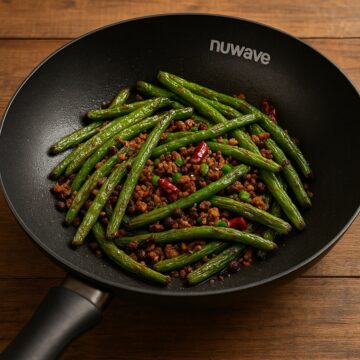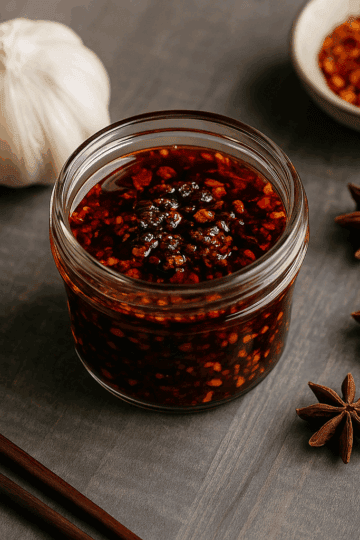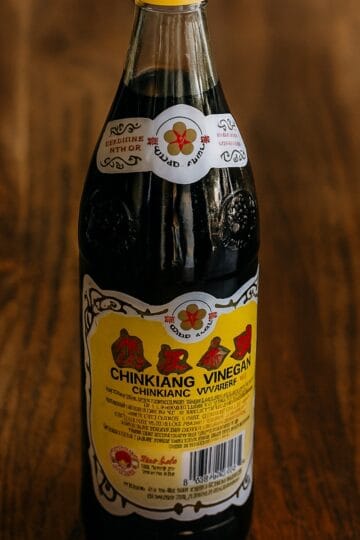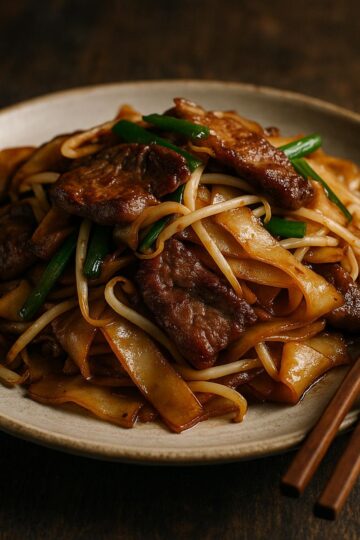What Is Dry-Frying (干煸)?
Dry-frying, or gān biān, is one of the defining techniques of Sichuan cooking. It looks simple — barely any oil, no sauce in sight — but it’s an art built on patience and control.
Instead of stir-frying quickly over roaring heat, ingredients like green beans, shredded pork, or eggplant are cooked longer over medium-high heat. This slow evaporation draws out moisture while caramelizing sugars and proteins, creating the signature wrinkled, smoky, and concentrated flavor unique to Sichuan street food.
Once the moisture is gone and the beans are blistered, aromatics like garlic, ginger, dried chiles, and doubanjiang (fermented chili bean paste) are tossed in, sizzling just long enough to perfume the dish. The result is neither oily nor saucy — just intensely flavored and irresistibly crisp-tender.
The key to mastering dry-frying is restraint: let the wok work. Don’t rush, don’t stir constantly, and never drown the ingredients. You’re not cooking in oil — you’re cooking in heat, smoke, and courage.
Heat, Smoke, and Street Grit
Chengdu doesn’t just cook—it performs combustion. Street stalls hiss with oil as beans hit the wok, and the air tastes like garlic and danger. This dish, Gan Bian Si Ji Dou, doesn’t care about refinement. It’s unapologetically dry, blistered, and smoky. No glossy sauce, no clever garnish. Just the raw pulse of Sichuan heat—the kind that makes you sweat, grin, and go back for more. You can almost hear the sizzle echo through narrow alleys and feel the sting of peppercorns in the air.
Textures, Temperatures, and the Moment Before the Bite
There’s a kind of music in the cooking: beans popping in the oil, garlic hissing, the faint metallic scent of the wok as smoke curls upward. Every sense is recruited. When the beans wrinkle and turn a deep, shimmering green, the air shifts—the fragrance becomes rounder, almost sweet. Take one bite: first the crisp edge, then the chew, then the numbing buzz that blooms like a second heartbeat. This isn’t heat that punishes; it seduces, builds, then releases you.
Intimate, Indulgent, and Personal
You’ll find yourself standing by the stove, eating these straight from the wok, one glossy bean at a time. They glisten in chili oil, tangled with pork and shards of garlic. The numbing tingle of peppercorn feels almost luxurious, a little wicked. There’s pleasure in the simplicity—beans, oil, and flame. Cooking them feels oddly sensual: the rhythm of stirring, the smell of toasted spice, the weight of the wok in your hand. This is comfort food for someone who’s lived a little.
Ingredients — The Cast of Flavor
Green Beans (四季豆): The stoic backbone of the dish. They endure the heat, their skins wrinkling and darkening until they drink in every note of chili and smoke.
Ground Pork: The baritone—rich, savory, understated. It carries the fat that transforms the aromatics into perfume.
Doubanjiang (豆瓣酱): The soul. Fermented broad beans and chili paste aged to a slow funk—like a memory that won’t fade. This gives the dish its deep, carmine undertone.
Sichuan Peppercorns (花椒): Not fire, but vibration. A citrus-tinged electricity that wakes the palate.
Garlic and Ginger: The twin anchors—garlic for punch, ginger for warmth. Together, they give the dish its heartbeat.
Shaoxing Wine: The soft note at the end of the riff—rounding the salt and fire with quiet sweetness.
Recipe Ingredients
Ingredients
- 1 lb (450g) green beans, trimmed
- 3 tablespoon neutral oil (peanut or canola)
- 3 oz (85g) ground pork (optional but traditional)
- 3 cloves garlic, minced
- 1-inch knob fresh ginger, minced
- 2–3 dried red chiles, broken
- 1 teaspoon whole Sichuan peppercorns
- 1 tablespoon doubanjiang (or chili crisp if unavailable)
- 1 tablespoon soy sauce
- 1 teaspoon Shaoxing wine
- ½ teaspoon sugar
- 1 scallion, finely sliced
Instructions
- Heat the oil in a wok until shimmering. Add green beans and stir-fry until skins blister and wrinkle, about 6–8 minutes. Remove and drain.
- Add ground pork to the same wok. Stir-fry until browned and slightly crisp.
- Push pork to the side and add peppercorns and chiles; stir until fragrant.
- Add garlic, ginger, and doubanjiang. Stir-fry for 30 seconds.
- Add soy sauce, Shaoxing wine, and sugar. Return beans to the wok and toss to coat.
- Finish with scallions and a drizzle of chili oil if desired. Serve immediately.
Chef Notes & Hacks
Pat the beans dry before frying—moisture kills the blister. The “dry-fry” method uses more oil than stir-fry but less than deep-fry—about ¼ inch in the wok. If using vegetarian protein, choose diced king oyster mushrooms for a meaty chew and splash a bit of light soy to enhance umami.
Table Itinerary
Starter: Cold garlic cucumber salad (Liang Ban Huang Gua)
Main: Dan Dan Noodles or Twice-Cooked Pork
Dessert: Black sesame panna cotta or lychee sorbet
Drink Pairing: Tsingtao beer, jasmine iced tea, or chilled gin and tonic
Storage
Best eaten hot. Leftovers can be stored in the fridge for up to 2 days, but the magic—like a good jazz solo—doesn’t repeat. Reheat in a hot dry pan to revive the flavor.

Sichuan Green Beans
Ingredients
Ingredients
- 1 lb green beans, trimmed 450g
- 3 tablespoon neutral oil peanut or canola
- 3 oz 85g ground pork (optional but traditional)
- 3 cloves garlic minced
- 1- inch knob fresh ginger minced
- 2 dried red chiles broken
- 1 teaspoon Sichuan peppercorns
- 1 tablespoon doubanjiang or chili crisp if unavailable
- 1 tablespoon soy sauce
- 1 teaspoon Shaoxing wine
- ½ teaspoon sugar
- 1 scallion finely sliced
Instructions
Instructions
- Heat the oil in a wok until shimmering. Add green beans and stir-fry until skins blister and wrinkle, about 6–8 minutes. Remove and drain.
- Add ground pork to the same wok. Stir-fry until browned and slightly crisp.
- Push pork to the side and add peppercorns and chiles; stir until fragrant.
- Add garlic, ginger, and doubanjiang. Stir-fry for 30 seconds.
- Add soy sauce, Shaoxing wine, and sugar. Return beans to the wok and toss to coat.
- Finish with scallions and a drizzle of chili oil if desired. Serve immediately.
Notes
Pat the beans dry before frying—moisture kills the blister. The “dry-fry” method uses more oil than stir-fry but less than deep-fry—about ¼ inch in the wok. If using vegetarian protein, choose diced king oyster mushrooms for a meaty chew and splash a bit of light soy to enhance umami.





Comments
No Comments